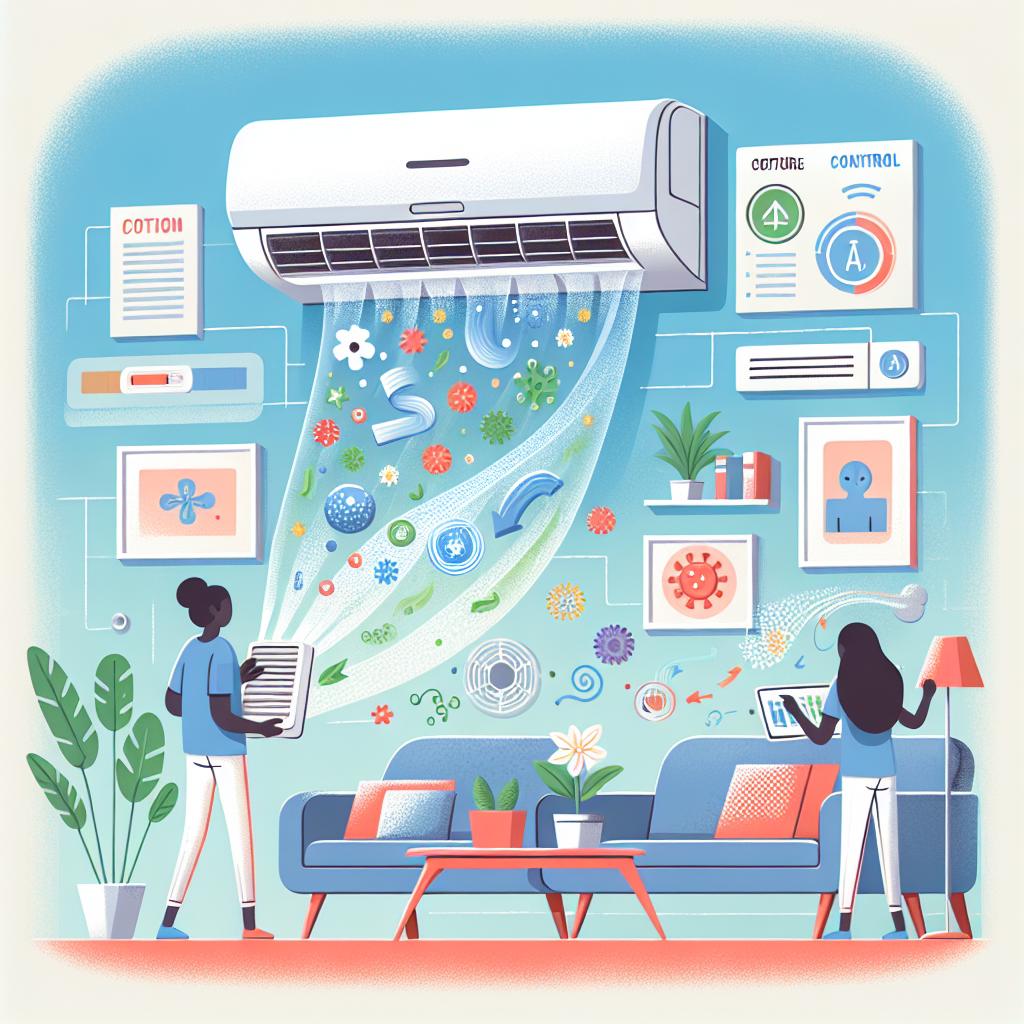In the bustling world of commercial spaces, where productivity and comfort often go hand in hand, maintaining a healthy environment is paramount. Amidst the clamor of office chatter, the aroma of freshly brewed coffee, and the subtle hum of machinery, one often overlooked player emerges as a silent guardian of indoor air quality: the mini split air conditioner. This versatile HVAC system not only cools or heats a space but plays a crucial role in filtering out impurities, regulating humidity, and ensuring a steady supply of fresh air. As businesses increasingly prioritize employee well-being and operational efficiency, understanding the transformative impact of mini split AC units on air quality is more relevant than ever. Join us as we explore the multifaceted benefits of these compact yet powerful systems and their indispensable contribution to creating a healthier commercial environment.
Understanding the Mechanisms of Mini Split AC Systems for Enhanced Air Quality
Mini split AC systems operate through a series of carefully coordinated components that play a critical role in both temperature control and air quality enhancement. At the heart of these systems are two main units: the outdoor unit, which dissipates heat, and one or more indoor units that circulate cooled air. These units utilize refrigerant to absorb heat from inside the space and expel it outside, ensuring a comfortable environment. Multi-zone capabilities allow these systems to cater to different areas or rooms simultaneously, offering tailored cooling solutions that significantly reduce energy consumption compared to traditional HVAC systems. Additionally, the use of inverter technology in mini splits contributes to maintaining optimal indoor conditions by adjusting compressor speeds based on the cooling demand, thereby minimizing fluctuations in temperature that could lead to discomfort and air quality issues.
Another essential mechanism found in mini split systems is their advanced filtration systems, which are designed to tackle airborne pollutants effectively. These systems often incorporate multi-stage filters that can trap dust, pollen, pet dander, and even microscopic allergens, ensuring cleaner air circulation within commercial spaces. Moreover, many models feature built-in ionizers and UV cleansing technologies, further enhancing air quality by neutralizing harmful bacteria and viruses. The result is not only a comfortable environment but also a healthier one for employees and customers alike. Understanding these intricacies showcases how mini split AC systems go beyond temperature control, serving as vital components in the comprehensive management of air quality in commercial establishments, ultimately contributing to better overall health and productivity.

Impact of Mini Split AC on Humidity Control and Its Significance in Commercial Settings
The impact of mini split AC systems on humidity control is significant, particularly in commercial environments where air quality is paramount. Unlike traditional HVAC systems, mini splits offer targeted climate control, allowing for better management of humidity levels. This is crucial in spaces such as restaurants, fitness centers, and offices, where high humidity can lead to discomfort, mold growth, and reduced productivity. By effectively regulating moisture in the air, mini split systems help maintain a comfortable atmosphere that promotes employee efficiency and customer satisfaction.
Furthermore, the significance of proper humidity control cannot be overstated in commercial settings. A well-maintained humidity level—generally between 30% and 50%—can dramatically improve air quality. This equilibrium not only ensures that equipment operates optimally, but also minimizes health risks associated with dry air or excessive moisture. The key benefits include:
- Improved Comfort: Proper humidity levels contribute to overall thermal comfort for employees and clients.
- Health Benefits: Balanced humidity can reduce allergens and respiratory issues.
- Mold Prevention: Effective moisture control helps in inhibiting mold growth, protecting both the building and its occupants.
the role of mini split AC systems in controlling humidity is an essential aspect of their functionality in commercial spaces, ensuring a healthy and productive environment for all users.

Best Practices for Utilizing Mini Split AC to Optimize Indoor Air Quality
To ensure optimal indoor air quality while using a mini-split AC system, regular maintenance is vital. This includes cleaning or replacing filters every 1-3 months to prevent dust and allergens from circulating in the air. Additionally, scheduling seasonal check-ups by a qualified technician can help identify potential issues, ensuring the system operates efficiently. Here are some best practices to keep in mind:
- Position your indoor units wisely to promote better airflow and enhance circulation.
- Utilize the dehumidification feature during humid months, which can significantly improve air quality.
- Integrate air purifiers with your mini-split system for an added layer of filtration.
- Monitor indoor humidity levels to maintain a balanced environment, ideally between 30-50%.
It is also important to take advantage of the zoning capabilities that mini-split systems offer. Each indoor unit can be controlled independently, allowing for tailored comfort levels in different areas of a commercial space. This zoning not only enhances comfort but also enables targeted filtration methods where they are needed most. Consider the following strategies:
| Zone | Optimal Temperature | Recommended Humidity |
|---|---|---|
| Reception Area | 72°F | 40-45% |
| Conference Room | 68°F | 30-35% |
| Break Room | 75°F | 50-60% |

Future Trends: Innovations in Mini Split Technology and Their Influence on Air Quality Management
The landscape of mini split technology is evolving rapidly, with innovations that promise to enhance efficiency and contribute significantly to indoor air quality management. Advanced filtration systems are at the forefront of these developments, incorporating multi-stage filters that can capture not just dust and pollen, but also volatile organic compounds (VOCs) and other pollutants. As businesses grapple with the importance of healthy indoor environments, integrated air quality sensors will become standard features, allowing real-time monitoring of air quality parameters. This data empowers facility managers to make informed decisions, adjusting air purification processes in response to fluctuating indoor pollution levels.
In addition to improvements in filtration, the future will likely see enhancements in smart technology integration within mini split systems. These systems will use Internet of Things (IoT) capabilities to adaptively control temperature and humidity levels, optimizing comfort while minimizing energy use. By leveraging predictive analytics, mini split units will be able to adjust in real-time based on occupancy and activity levels, thus maintaining a consistent air quality standard. As energy efficiency becomes increasingly critical, the introduction of more sustainable refrigerants and energy recovery ventilators will further position mini split technology as a leader in air quality management solutions in commercial spaces.
Q&A
Q&A: The Role of Mini Split AC in Maintaining Air Quality in Commercial Spaces
Q1: What is a mini split AC system, and how does it differ from traditional HVAC systems?
A: A mini split AC system is an innovative air conditioning solution that consists of two main components: an outdoor compressor unit and one or more indoor air-handling units. Unlike traditional HVAC systems that use ductwork to distribute air, mini splits are ductless, allowing for more flexibility in installation and zoning. This design makes them an excellent choice for commercial spaces, where different areas may have varying cooling needs.
Q2: How do mini split AC systems contribute to better air quality in commercial environments?
A: Mini split AC systems enhance air quality by providing efficient air filtration and circulation. Many units come equipped with multi-stage filtration systems that capture dust, allergens, and other airborne particles. As they operate, these systems continuously circulate and refresh the indoor air, reducing contaminants and maintaining a healthier environment for employees and customers alike.
Q3: In what ways can mini split systems be more energy-efficient than traditional systems?
A: Mini split systems are generally more energy-efficient due to their inverter technology, which adjusts the compressor speed based on cooling or heating demand rather than turning on and off like traditional systems. This efficiency helps lower energy bills while minimizing the environmental impact—factors that are crucial for sustainability in commercial spaces.
Q4: Are there specific commercial scenarios where mini split AC systems perform better?
A: Yes, mini split systems excel in scenarios where zoning is essential. For instance, in open-plan offices or multi-room clinics, different areas may have distinct temperature preferences. Mini splits allow for individualized control, ensuring comfort and efficient air quality management across varying spaces—something traditional systems often struggle to accommodate.
Q5: What maintenance practices should be implemented to ensure mini split AC systems effectively maintain air quality?
A: Regular maintenance is key to ensuring optimal performance. This includes cleaning or replacing air filters every few months, cleaning the coils, and checking the drain line for clogs. Additionally, having a professional technician inspect the units annually can help identify and address any potential issues before they affect air quality or system efficiency.
Q6: Can mini split AC systems impact humidity levels in a commercial space?
A: Absolutely! Mini split systems are designed to dehumidify air as they cool it. This dual function is particularly beneficial in humid environments, where excess moisture can lead to mold growth and a decrease in air quality. By effectively managing humidity levels, mini splits help create a more comfortable and healthier atmosphere in commercial settings.
Q7: What are some potential drawbacks of using mini split AC systems in commercial spaces?
A: While mini split systems offer numerous benefits, they do have some drawbacks. Initial installation costs can be higher compared to traditional systems, particularly if multiple indoor units are required. Additionally, the visible indoor units may not align with every aesthetic preference. Nonetheless, these challenges can often be outweighed by the long-term gains in efficiency and air quality.
Q8: How can business owners decide if a mini split AC system is the right choice for their space?
A: Business owners should consider factors such as the size of their space, air conditioning needs, existing infrastructure, and budget. Consulting with an HVAC specialist can provide tailored advice. Furthermore, exploring the specific air quality challenges faced in their commercial environment will help determine if a mini split system can effectively address those needs.
This Q&A provides an overview of the significant role mini split AC systems can play in maintaining air quality in commercial spaces, highlighting both their benefits and considerations for effective use.
Key Takeaways
the integration of mini split air conditioning systems into commercial spaces is more than a matter of comfort; it is a pivotal factor in ensuring optimal air quality. As these systems seamlessly blend efficiency with versatility, they empower businesses to create healthier environments for both employees and customers. By regulating temperature and filtering pollutants, mini splits help mitigate the effects of outdoor allergens and indoor contaminants, transforming how we perceive and interact with our surroundings.
As we move forward into a future increasingly focused on wellness and sustainability, embracing innovative solutions like mini split ACs not only enhances our immediate environments but also supports broader public health objectives. In the quest for cleaner air within commercial settings, these systems stand out as indispensable allies. It’s an investment in comfort, productivity, and, ultimately, the well-being of all who inhabit these spaces.

